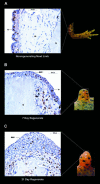Unraveling the molecular basis for regenerative cellular plasticity
- PMID: 15314652
- PMCID: PMC509298
- DOI: 10.1371/journal.pbio.0020232
Unraveling the molecular basis for regenerative cellular plasticity
Abstract
Identifying the molecular basis for the impressive regenerative capacities of some organisms may help us to devise effective methods for enhancing regeneration in mammals
Figures

References
-
- Aristotle . Historia Animalium. In: Peck AL, translator. Vol. 1. Cambridge: Harvard University Press; 1965. 239 pp.
-
- Beck CW, Christen B, Slack JM. Molecular pathways needed for regeneration of spinal cord and muscle in a vertebrate. Dev Cell. 2003;5:429–439. - PubMed
-
- Bodemer CW, Everett NB. Localization of newly synthesized proteins in regenerating newt limbs as determined by radioautographic localization of injected methionine-S35. Dev Biol. 1959;1:327–342.
-
- Borgens RB. Mice regrow the tips of their foretoes. Science. 1982;217:747–750. - PubMed
-
- Chalkley DT. A quantitative histological analysis of forelimb regeneration in Triturus viridescens . J Morphol. 1954;94:21–70.
Publication types
MeSH terms
Substances
Associated data
- Actions
- Actions
- Actions
- Actions
- Actions
- Actions
Grants and funding
LinkOut - more resources
Full Text Sources
Medical

